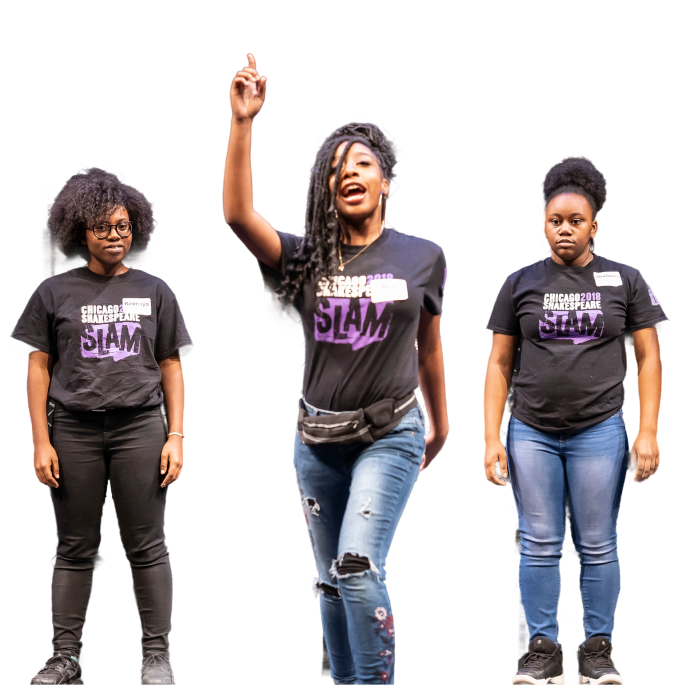


High School Arts Offerings
September 2023
Introduction
The 2021-22 State of the Arts Report (SOTA), published in April 2023, provided a landscape view of how Chicago Public Schools (CPS) and the Arts Partner community fared in bringing the arts to CPS students. Within SOTA, there were various insights on high school arts offerings. For the 2021-22 school year, the data showed that:
- 71% of high schools in CPS met or nearly met the standards for the breadth and depth of disciplines offered that are outlined in the CPS Arts Education Plan.
- The number of high schools offering coursework increased in all disciplines but media arts from 2020-21 to 2021-22.
- The average number of disciplines offered has steadily increased since 2018-19.
- Only 2% of high schools reported no arts courses offered.
- Only 1% of high schools reported having no arts teacher.
In view of these findings, this Data Snapshot seeks to understand how high school arts staffing and coursework offerings changed during the past three school years since the onset of the COVID-19 pandemic, especially in relation to geographic region1 and school governance structure2.
As for the school years of analysis, 2019-20 can be considered a pre-pandemic year since respondents were asked to report on arts offerings prior to March 2020. The 2020-21 school year was a full year of remote instruction, and in 2021-22 the District resumed in-person instruction. For the 2021-22 school year, many measures of students’ access to and quality of arts education opportunities rebounded since the 2020-21 school year. The analyses in this Snapshot use data provided by over 80% of high schools in the district3. The findings reported are as of June 2023.
This Data Snapshot explores the following questions:
- How does access to high school arts offerings look across the city? How does access change year-over-year?
- What is the relationship between school governance structure and arts access? How do arts offerings compare between District-Managed high schools and Non-District Managed high schools?
Key Findings
- Recovery Since the Onset of the COVID-19 Pandemic: In 2021-22, more schools in regions throughout Chicago increased their high schools arts offerings, especially South side regions.
- Geography and Stability in Arts Offerings: South and West regions of Chicago tended to experience more volatility in high school arts staffing and coursework over the course of the last three school years.
- School Governance Structure: Throughout the last three school years, Non-District Managed high schools on average offered fewer disciplines and sequential pathways in a given discipline, and were significantly less likely than District-Managed high schools to have adequate staffing.
High School Arts: Instructors
Arts instructors are key to providing students with a rich breadth and depth of arts coursework. This map highlights arts staffing across the sector since the 2019-20 school year and staffing by artistic discipline (visual arts, music, theatre, dance, media arts, and literary arts). These sixteen regions are defined by Chicago Public Schools’ Annual Regional Analysis (ARA)4.
The first tab examines the average number of students to arts instructors (staffing ratio) by ARA region. The different school years can be selected on the left panel. Hover over each ARA region to see the number of high schools, students, arts instructors, and the average staffing ratio.
It is worth noting that high schools tend to do well in arts staffing, with 81% of high schools having 350 students or fewer per arts instructor in 2021-22, meeting the benchmark for arts staffing5. See how the color by region changes throughout the different school years. Darker colors indicate a better staffing ratio.
The Greater Stony Island region had the highest average number of students to instructors in 2019-20 and 2020-21, though the staffing ratio improved in 2021-22. Chicago regions such as Far Northwest Side, West Side, Far Southwest Side, and Greater Calumet had an improved staffing ratio (lower average number of students to instructor) in 2021-22. More regions throughout Chicago had a better arts staffing ratio in 2021-22, compared to 2019-20 and 2020-21. Arts access has rebounded and improved since the onset of the COVID-19 pandemic.
The second tab examines the same data, but by artistic discipline. On the left panel, select different school years and artistic disciplines. Visual arts and music are the most common disciplines of focus of arts instructors throughout the three school years. Notable changes in visual arts instructor ratios emerge in schools in the Pilsen, Little Village, South Side, and Greater Stony Island regions. Schools in these regions experienced increases in average number of students to visual arts instructors ratio since 2019-20, indicating a worse staffing ratio. Dance instructors were consistently unavailable to students in Pilsen, Little Village, Far SW Side, and Greater Stony Island. In 2021-22, South side regions had some of the best staffing ratios in theatre. Notably, the Milwaukee Avenue region had the best staffing ratio across all disciplines in 2021-22. In the 2021-22 school year, South side regions had fewer students per instructor (better staffing ratios) of less commonly offered disciplines, such as theatre, dance, media arts, and literary arts, compared to prior school years.
High School Arts Offerings: Disciplines
This visualization examines the average number of disciplines and the average number of multi-level disciplines offered by ARA region. Multi-level disciplines refer to disciplines that have sequential pathways of offerings, such as beginner, intermediate, and advanced coursework. Students need a variety of breadth and depth of arts courses in order to gain exposure and knowledge in any given discipline.
How many disciplines are offered on average throughout the city? How does this change during the course of the COVID-19 pandemic? Use the first tab to explore these questions by ARA region.
Throughout the three school years, South and West side regions, such as West Side, Greater Stockyards, South Side, and Greater Stony Island, tended to offer fewer than three disciplines. In addition, within the past three school years, the South and West side regions tended to experience the most volatility year-over-year in the number of disciplines offered.
What do multi-level discipline offerings look like across the city? The second tab explores the average number of multi-level disciplines schools offered by ARA region. Out of all regions, schools in the Greater Stony Island and South Side regions offered less than one multi-level discipline on average throughout all three years. Schools in other regions such as Northwest Side, North Lakefront, Greater Lincoln Park, and Greater Stockyards consistently offer two to three multi-level disciplines. South and West side regions were more likely to offer fewer multi-level disciplines than the District-wide average of 1.5.
High School Arts Offerings: District-Managed and Non-District Managed Schools
2021-22 Arts Offerings by School Governance
|
District-Managed Schools |
Non-District Managed Schools |
|
| % of Schools that have 350 or fewer students per arts instructor | 91% | 68% |
| Average Number of Disciplines Offered | 2.6 | 2.1 |
| Average Number of Multi-level Disciplines Offered | 1.9 | 1.1 |
School governance structure is a factor in arts education access in CPS7 . A significantly higher percentage of District-Managed high schools had 350 or fewer students per arts instructor than Non-District Managed high schools8. District-Managed high schools also tended to offer more disciplines as well as more multi-level disciplines. Students attending Non-District Managed schools on average had access to almost one fewer multi-level discipline.
The application below contains more in-depth information on these metrics across the previous three school years.
Interact with the tabs to look at high schools arts offerings between District-Managed and Non-District managed schools, including arts staffing and coursework.
There was over a 20 percentage point difference between District-Managed and Non-District Managed schools with adequate staffing (350 or fewer students per arts instructor). Over 90% of District-Managed schools had 350 students or fewer per arts instructor while only 60-70% of Non-District Managed schools had 350 students or fewer per arts instructor in the previous three school years9. Non-District Managed schools offered on average roughly 0.5 fewer disciplines and one fewer multi-level discipline when compared to District-Managed schools.
For the past three school years, Non-District Managed high schools were significantly less likely than District-Managed high schools to have adequate arts staffing; these schools also offered coursework in fewer artistic disciplines, and with fewer sequential options.
Conclusion
Arts staffing and a rich breadth and depth of arts coursework are key to ensuring CPS high school students have access to a high-quality arts education.
During the COVID-19 pandemic, instructional methods changed dramatically, resulting in critical changes in arts access across Chicago’s high schools. While some of these metrics have rebounded since the onset of the pandemic, significant gaps in equitable access to the arts remain – especially based on the school governance structure and the location of the school that students attend.
This Data Snapshot, along with Ingenuity’s other publications and resources, is designed to be a crucial tool in the development and deployment of collective strategies that close the gaps in arts education access — and push us toward a future in which every CPS student has access to a high-quality arts education.
1 Geographic regions refer to Annual Regional Analysis (ARA). See more at https://www.cps.edu/sites/ara/district-overview/.
2 School governance indicates whether a school is District or Non-District managed. For statistics across the District, see https://www.cps.edu/about/stats-facts/. Non-District managed schools include charter school campuses, contract schools, Alternative Learning Opportunities Programs (ALOP) and SAFE schools. See https://www.cps.edu/about/departments/innovation-and-incubation/ for more information.
3 The analyses were done using data from the same 122 high schools that have taken the Creative Schools Survey for the past three school years (2019-20, 2020-21, and 2021-22). This constitutes over 80% of high schools in the district.
4 Annual Regional Analysis (ARA) were developed in partnership with Kids First Chicago. The regions are aligned with planning zones that were created by the City of Chicago’s Department of Planning and Development. These regions are more stable than city wards and school networks, since schools may change networks from year to year, and allow us to visualize patterns across the city.
5 See Creative Schools Certification.
6 The benchmark of 350 or fewer students per arts instructor meets CPS Arts Education Plan goals. See the Creative Schools Certification for more details.
7 See Data Snapshot “Arts Education Access in CPS: How school size, type, and student demographics impact 2019-20 Creative Schools Certification”.
8 Non-District managed schools include charter school campuses, contract schools, Alternative Learning Opportunities Programs (ALOP) and SAFE Schools. See https://www.cps.edu/about/departments/innovation-and-incubation/ for more information.
9 There are 88 District-Managed schools and 34 Non-District managed schools that provided data across all three school years.
